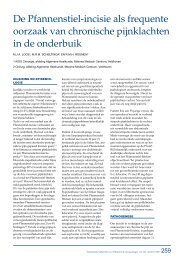Surgical management of chronic inguinal pain syndromes - Liespijn
Surgical management of chronic inguinal pain syndromes - Liespijn
Surgical management of chronic inguinal pain syndromes - Liespijn
You also want an ePaper? Increase the reach of your titles
YUMPU automatically turns print PDFs into web optimized ePapers that Google loves.
deliveries (CD) and vaginal births (VB) 24 . Based on an intention to treat analysis, theyconcluded that the total reported <strong>pain</strong> was similar in both groups (planned CD 21% vs.planned VB 22.2%). However, when those patients who actually had a CD (n=611) werecompared to those who underwent a VB (n=306), it appeared that CD patients more<strong>of</strong>ten complained <strong>of</strong> abdominal <strong>pain</strong> (outside 4.7% / deep 6.2% / total 10.9%) than thoseafter VB (outside 1.6% / deep 3.9% / total 5.5%). In our opinion, this significant difference(by Fisher’s exact test) is most probably associated with the surgical abdominalintervention itself and partially scar-related. Another study using questionnaires amonga group <strong>of</strong> patients with ‘Pfannenstiels’ (93% <strong>of</strong> 221 CD patients), identified a 12.3% lowerabdominal <strong>pain</strong> prevalence after one year, but grade was not reported 25 . Similarly, <strong>chronic</strong><strong>pain</strong> was mentioned by 23% <strong>of</strong> patients 5 years after a Pfannenstiel incision, but alsonot graded (n=243) 18 . Results <strong>of</strong> these and our study indicate that post-Pfannenstiel<strong>pain</strong> is common, even after an extended time period. Most women are thought toaccept this <strong>chronic</strong> <strong>pain</strong>, although one out <strong>of</strong> twelve patients consulted a physician andreceived symptomatic medical treatment.Why do some patients develop severe postoperative <strong>pain</strong> following a Pfannenstielincision whereas others do not? Previous research identified length <strong>of</strong> incision as anexclusive factor for <strong>pain</strong> development 18 . The innervating nerves <strong>of</strong> the suprapubic areaand lower abdominal portions are easily damaged or trapped when the incision isextended beyond lateral edges <strong>of</strong> the rectus sheath (‘danger area’). Moreover, suturesor scar tissue trapping nervous tissue as well as neuroma formation may also result inneuropathic <strong>pain</strong>. Although the present study could not confirm scar length as a risk factorfor <strong>pain</strong>, 70% <strong>of</strong> all women experienced <strong>pain</strong> in lateral portions <strong>of</strong> the scar indicatingthe lateral borders <strong>of</strong> importance in Pfannenstiel <strong>pain</strong> mechanism. Other significant<strong>chronic</strong> <strong>pain</strong> predictors include regional numbness and recurrent surgery, denominatorsthat were also found important in a recent study evaluating <strong>pain</strong> after <strong>inguinal</strong> herniarepair 17 . Increased risk <strong>of</strong> nerve entrapment after recurrent surgery is likely due to thedevelopment <strong>of</strong> larger areas <strong>of</strong> fibrosis. An additional risk for <strong>pain</strong> was an emergency CDcompared to an elective operation. One may hypothesize that suboptimal conditionsand a stressed surgical technique may enhance iatrogenic traumatisation <strong>of</strong> nerves andother tissues. The identification <strong>of</strong> risk factors for postoperative Pfannenstiel <strong>pain</strong> maybe used in optimizing the surgical technique as well as the process <strong>of</strong> informed consentprior to a surgical procedure.One may question the value <strong>of</strong> a questionnaire as a means <strong>of</strong> detecting the origin <strong>of</strong><strong>pain</strong>, as visceral <strong>pain</strong> is <strong>of</strong>ten difficult to distinguish from parietal <strong>pain</strong> 26 . Assessment <strong>of</strong>nerve involvement and other abdominal wall pathology requires physical examinationwith additional testing performed by specialists trained in recognizing patterns <strong>of</strong> <strong>pain</strong>.In the present study a little over half <strong>of</strong> all patients (32/61) reporting moderate to severe<strong>pain</strong> were interviewed and underwent a physical examination. Interestingly, more thanhalf <strong>of</strong> this population (17/32) was diagnosed with entrapment <strong>of</strong> iliohypogastric orilio<strong>inguinal</strong> nerves. With the limited number <strong>of</strong> examined patients, this percentage(2.5%, 17/690) approximating a previously reported incidence <strong>of</strong> 2.3% is probably anunderestimation 18 . Interestingly, two patients with nerve entrapment who received asingle lidocain block experienced ongoing <strong>pain</strong> relief. This phenomenon, also describedin postherniorrhaphy groin <strong>pain</strong> patients, may possibly be explained by the hypothesis<strong>of</strong> resetting <strong>pain</strong> stimulation thresholds 23 . Nerve block failure (as in three patients withneuropathic <strong>pain</strong> symptoms) may indicate that the central nervous system is inflictedas well, eliminating the possibility <strong>of</strong> <strong>pain</strong> reduction by blocking peripheral nerves.However, anaesthetic blocks in suspected nerve entrapment <strong>syndromes</strong> are importantas diagnostic and possibly therapeutic measures.The present inventarisation has identified a variety <strong>of</strong> diagnoses including several nonneuropathic<strong>syndromes</strong> following a Pfannenstiel incision. Although not encounteredin the present study, cutaneous endometriomas in Pfannenstiel incisions have beenpreviously described 27,28 . Furthermore, lower abdominal <strong>pain</strong> following abdominalsurgery may also be <strong>of</strong> visceral origin, such as intra-abdominal adhesions associatedwith frequent complaints <strong>of</strong> altered bowel habits 29 .Although long-term <strong>pain</strong> after a Pfannenstiel incision has been identified in some earlierstudies, the present study demonstrates the large prevalence <strong>of</strong> Pfannenstiel <strong>pain</strong>with contributing risk factors 30 . Doctor’s delay and unnecessary psychosomatisation <strong>of</strong><strong>pain</strong> complaints, events that frequently occurred in this patient population, may beavoided if awareness <strong>of</strong> these <strong>pain</strong> <strong>syndromes</strong> is increased.In conclusion, <strong>chronic</strong> <strong>pain</strong> following a Pfannenstiel incision is common. Nerve entrapmentwas found to be a frequent cause <strong>of</strong> moderate to severe <strong>pain</strong>.APPENDIXQuestionnaire1 How <strong>of</strong>ten did you experience <strong>pain</strong> at the lower transverse abdominal scar during theprevious month?Never/ occasionally/ regularly/ always2 How intense was the <strong>pain</strong> at the lower transverse abdominal scar during the previousmonth?None/ mild/ moderate/ severe3 Please choose one or more <strong>of</strong> the following characteristics best describing your <strong>pain</strong>at the lower transverse abdominal scar during the previous month.Burning, stabbing, sharp, electric, prickling, gnawing, pounding, pinching, nagging, pulling4 Please mark with an x the exact location <strong>of</strong> your <strong>pain</strong> during the previous monthusing the following schematic drawing (figure 1).5 Please measure the length <strong>of</strong> the lower transverse abdominal scar. Length scar =…….cm44 Chapter 3The Pfannenstiel approach as a source <strong>of</strong> <strong>chronic</strong> <strong>pain</strong> 45





